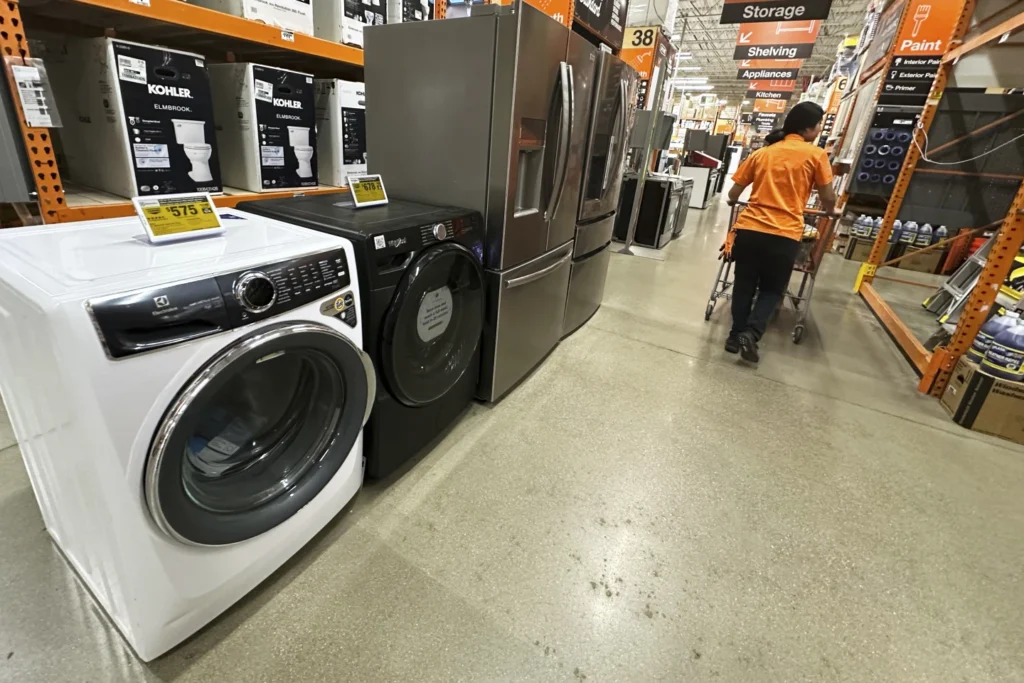What US Consumers Can Expect from Trump’s New Tariffs

What US Consumers Can Expect from Trump’s New Tariffs
WASHINGTON (AP) — American consumers will soon feel the effects of President Donald Trump’s new tariffs, which impose higher taxes on imports from nearly 70 countries. Prices are already rising, and more increases are expected across common goods like clothes, food, and alcohol.
Trump’s updated trade agenda marks the highest average import tax rate in the U.S. since 1933. The tariffs range from 15% to 55%, depending on the country and product. A 55% tariff on Chinese-made goods could begin next week if no trade deal is reached.
Tariffs Hit Businesses and Consumers Alike
Since February, companies have been navigating unstable trade conditions. While some automakers have absorbed the costs, new government data shows retail prices started rising in June, especially for groceries, furniture, and appliances.
According to Yale’s Budget Lab, the new tariffs will raise prices 1.8% in the short term. That’s about a $2,400 loss in income per U.S. household.
“Retailers have been able to hold the line on pricing so far, but the new tariffs will significantly raise costs,” said Jon Gold of the National Retail Federation.
A Timeline of Tariff Increases
Trump introduced sweeping import taxes in April on goods from the European Union, Taiwan, Lesotho, and others. After a brief pause, he implemented a 10% tax on most imports, then warned countries of higher rates starting August 1. That deadline was extended to August 7.
-
Canada: 35% tariff, delayed by trade agreement
-
Mexico: Exempt for now due to NAFTA successor deal
-
India: Tariffs on Russian oil increased from 25% to 50%
-
Brazil: 50% tariff on all goods
-
Aluminum and steel: 50% tariff announced in June
-
Pharmaceuticals and chips: Pending additional tariffs
The U.S. may soon apply 100% tariffs on foreign-made computer chips, and tariffs on imported drugs are in the works.
Prices Already on the Rise
The U.S. Commerce Department reported a 2.6% increase in prices in June, up from 2.4% in May. The Consumer Price Index also showed inflation gains, especially in imported goods.
Categories Most Affected
Clothing and Footwear
Clothes and shoes are hit especially hard. Yale’s analysis estimates:
-
Shoe prices: +39% short-term, +19% long-term
-
Apparel prices: +37% short-term, +18% long-term
Food and Beverages
According to the Tax Foundation, items like bananas, coffee, fish, beer, and liquor will rise in price due to limited domestic production.
The U.S. Wine Trade Alliance warned that a 15% tariff on European alcohol could cause:
-
25,000+ job losses
-
$2 billion in lost sales
“We need toasts, not tariffs,” the alliance told Trump in a public letter.
Wine prices may surge 30% by September, according to Ben Aneff, the alliance’s president.
Car Prices Could Climb Next
Ferrari already added a 10% surcharge on U.S. cars while awaiting more tariff clarity. Other automakers have held off so far.
But this may change. General Motors expects a $4–5 billion impact from tariffs in 2025. Toyota reported a 37% drop in quarterly profits, partly due to tariffs.
Legal Challenges and E-Commerce Impact
Trump’s use of emergency powers to impose tariffs is now being challenged in court, with the Supreme Court likely to weigh in.
The “de minimis” rule, which allowed packages under $800 to enter the U.S. duty-free, will be suspended August 29. This impacts e-commerce shipments from all countries. China and Hong Kong lost this exemption in April.
Summary: What to Expect
| Category | Projected Impact |
|---|---|
| Shoes & Clothes | Prices up 30–40% in short term |
| Food & Drinks | Imports like wine, fish, coffee up 15–30% |
| Automobiles | Moderate price increases likely |
| E-Commerce Parcels | Duty-free exemptions ending Aug. 29 |
| Overall Inflation | Prices up 1.8%, costing $2,400/household |
: 193







